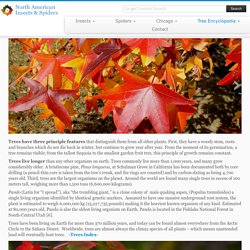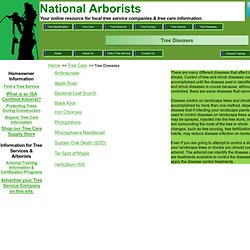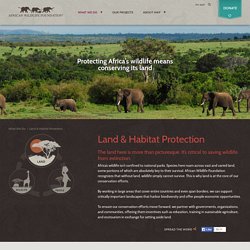

Tree Encyclopedia. Trees have three principle features that distinguish them from all other plants.

First, they have a woody stem, roots and branches which do not die back in winter, but continue to grow year after year. From the moment of its germination, a tree remains visible; from the tallest Sequoia to the smallest garden fruit tree, this principle of growth remains constant. Trees live longer than any other organism on earth. Trees commonly live more than 1,000 years, and many grow considerably older. A bristlecone pine, Pinus longaeva, at Schulman Grove in California has been documented both by core drilling (a pencil-thin core is taken from the tree’s trunk, and the rings are counted) and by carbon-dating as being 4,700 years old. Pando (Latin for “I spread”), aka “the trembling giant,” is a clone colony of male quaking aspen, (Populus tremuloides) a single living organism identified by identical genetic markers. Tree Disease identification, symptoms, treatment options for tree diseases. There are many different diseases that affect landscape trees and shrubs.

Control of tree and shrub diseases cannot be properly accomplished until the disease pest is identified. Identification of tree and shrub diseases is crucial because, although most diseases can be controlled, there are some diseases that cannot be controlled. Disease control on landscape trees and shrubs can sometimes be accomplished by more than one method, depending on the particular disease that if infecting your landscape plants. Fungicides are often used to control diseases on landscape trees and shrubs and fungicides may be sprayed, injected into the tree trunk, or even injected into the soil surrounding the roots of the tree or shrub.
Tree Identification Guide at arborday. EXPLORE TREES. Best Tree Finder: Tree Wizard. International Society of Arboriculture. I-Tree - Tools for Assessing and Managing Community Forests. US National Arboretum :. Society of American Foresters. The Fruit Tree Planting Foundation. Fruit Identification Outline.
A.

Achene: Very small, one-seeded fruit, usually produced in clusters. At maturity the pericarp is dry and free from the internal seed, except at the placental attachment. This is the typical fruit of the largest plant family, the sunflower family (Compositae or Asteraceae). Examples of this type of fruit include the sunflower (Helianthus), buttercup (Ranunculus) and sycamore (Platanus). In the sycamore, the globose fruiting heads are composed of tiny, one-seeded achenes interspersed with hairs (some authors refer to these individual fruits as nutlets).
B. C. D. One of the most painful schizocarps is the puncture vine (Tribulus terrestris). E. F. G. Note: Wayne's Word contains a lot of additional information about the remarkable duckweed family (Lemnaceae), the undisputed world's smallest flowering plants. Citrus ID: Home. Symptoms of Diseases and Disorders. Buy Trees and Learn About Trees - Visit our Online Nursery. The world's 10 oldest living trees. 10 Oldest Trees in the World. TreeHugger. <b>Growing Food Where the Sun Don’t Shine</b> Botany.com: Plant Encyclopedia to Identify Plants, Flowers, Trees & More. Plant Selector. Practical Plants.
Polycultures, Guilds & Companions...

In addition to each plant being able to record interactions with other individual plants, users can also create polycultures or guilds of known plant combinations that work well together. We are at the very start of our collection of polycultures with The Three Sisters set up as a quick example. You can create your own favourite polycultures here: An open encyclopedia of plant information There are plenty of sources of plant information online. It belongs to all of us Everything is editable by anybody, and licensed under a Creative Commons license to be used by anybody.
A specific focus for a broad audience. Plant Identification. Flowers. Plant Index. Land And Habitat Protection. Reason #48 to get involved Projects like our Natural Resource Management Plans, which designate zones for wildlife, biodiversity conservation, and tourism development, need funding to continue to benefit the land, wildlife, and local communities.

Reason #11 to get involved Wildlife corridors allow migratory species, like the wildebeest and zebra, to roam safely. Without intervention, these free spaces are threatened by increasing development and agriculture. Reason #24 to get involved The African wild dog population is at 6,600 and declining due to habitat fragmentation, human conflict, and widespread disease.
Reason #65 to get involved The Congo Shipping Project has drastically reduced the amount of land lost to unsustainable farming practices. Reason #37 to get involved The Sekute Conservation Area has resulted in increased education and conservation in the region. Reason #25 to get involved Reason #16 to get involved You can help protect one of man’s closest relatives—the endagered bonobo. Rainforest. In Brazil, which houses 30 percent of the remaining tropical rain forest on Earth, more than 50,000 square miles of rain forest were lost to deforestation between 2000 and 2005.

Biologists worry about the long-term consequences. Drought may be one. Some rain forests, including the Amazon, began experiencing drought in the 1990s, possibly due to deforestation and global warming. Efforts to discourage deforestation, mainly through sustainable-logging initiatives, are underway on a very limited basis but have had a negligible impact so far. The rain forest is nearly self-watering. Plants in the rain forest grow very close together and contend with the constant threat of insect predators. Rainforest Layers. Poison Ivy. Rainforest.